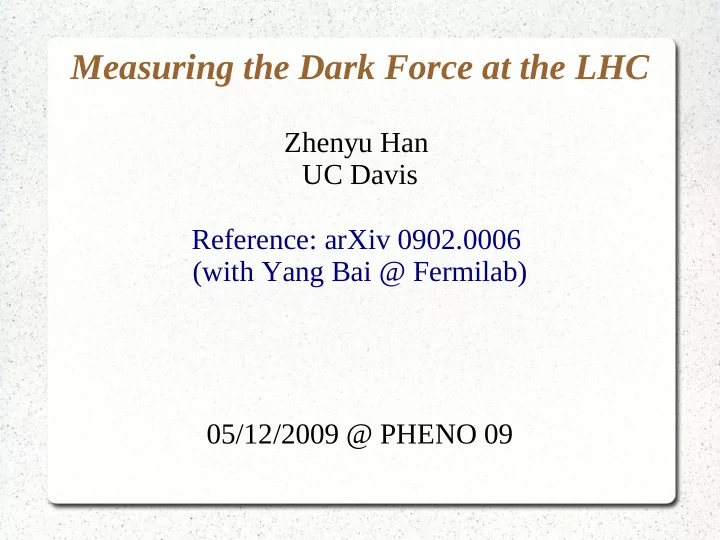

Measuring the Dark Force at the LHC Zhenyu Han UC Davis Reference: arXiv 0902.0006 (with Yang Bai @ Fermilab) 05/12/2009 @ PHENO 09
Outline ● Motivation – Positron/electron excesses in cosmic rays, PAMELA, ATIC, FERMI... – A class of dark matter models with a “dark force” mediated by a light (~GeV) particle: a ● Signature and measurements at the LHC – Lepton jets – Measurements: M a , M DM , g – A simple model as an illustration ● Conclusion
Positron/electron excesses in cosmic rays ● PAMELA: positron excess 10-100 GeV ● ATIC: positron/electron excess 300-800 GeV ● Fermi LAT: disfavors ATIC, but hint of positron/electron excess (?) Dark Matter annihilation to positron/electrons? What is the implication for the LHC?
DM annihilation (Arkani-Hamed, Finkbeiner, Slatyer and Weiner) – Dark matter annihilates to a light particle a – The particle a dominantly decays to leptons – Sommerfeld enhancement to give a large cross-section
Major ingredients for the LHC ● The relevant ingredients for the LHC: – An O(GeV) light particle a couples to the DM with order one coupling constant, mediating a “dark force” – The light particle a dominantly decays to leptons ● Two extra assumptions – DM (or other particles charged under the dark force) is produced at the LHC – The particle a decays within the detector ● Collinear leptons, “lepton jets” signature
Measuring the Dark Force ● What to measure: M DM , M a , g – Crucial for calculating DM-DM annihilation rate. – Consistent with PAMELA, ATIC, Fermi ...? – Give the right relic density?
The strategies Ma : measuring the invariant mass of the “lepton jet”. ● M DM : model-dependent, edges, m T2 , kinematic constraints..... ● The coupling g : dark radiation ● – For any process containing a DM, there is another one with an extra a radiated (extra “lepton jet”) – Significant rate: g ~ O(1), Ma ~ O(GeV)
A simple model with hidden U(1) ● A usual MSSM sector + hidden sector ● MSSM has a bino-like (N)LSP ● The dark sector: a supersymmetric (broken) U(1) gauge theory with Higgsino-like LSP, lighter than bino. ● DM: dark Higgsino, mediator: dark photon a dark= a ● Gauge mixing: a decays to leptons, MSSM bino decays to dark Higgsino + h dark
Benchmark numbers ● MSSM – MSSM LSP: 700 GeV – Squark 1000 GeV, gluino 1200 GeV, 0.84 pb for squark/gluino production. 8400 events for 10 inverse fb – All squarks decays directly to bino + quark ● Dark sector – M DM = 600 GeV – Ma = 1 GeV , Mh = 3 GeV (fine tuned), h->aa->4l (“h-jet”) – Coupling g = 0.41 (to give the correct relic density) ● Generated events with Madgraph/BRIDGE/Calchep/PYTHIA/PGS
Identify the lepton jets ● Group muons in small cones – All muons are sorted by p T – Take the highest p T muon as the seed of a lepton jet. – Add muons within 0.2 rad of the seed muon to the jet. Remove used muons from the list. – Repeat until all muons used ● Tag the jets – 4 or 3 muons: h-jet – 2 muons: a-jet – 5 or 6 muons? a and h tends to be colinear: “ h&a-jet”
M h , M a Measurements PGS 2-muon jets and 4-muon jets J/psi, dimuon, CMS Technical Design Report Resolution ~ m/100 Resolution ~ m/30 More precise than the other measurements
Determining m DM using kinematic constraints Count the number of events consistent with assumed masses.
Measuring the coupling g Dark radiation: 2-body decay vs 3 body-decay Count the number of 2h events and 2h+1a events, take the ratio = 2 R
Determining g ● For g =0.41, 10 inverse fb, expect 230 2h1a ( three- body decay ) events, 4k 2h events. 2h1a dominates the error. ● Count the number of events with 2 h -jets + 1 a -jet or 1 h -jet + 1 h&a -jet (5 or 6 muons): 70 events identified ● R = R( g , m) =>
Relic density ● Calculate the DM relic density (10 inverse fb) ● Compare with WMAP error: ● Not as precise, but encouraging if consistent
Conclusion and outlook ● It is possible to measure the dark force at the LHC – Important for calculating DM annihilation rate – Illustrated with a simple model ● Many theoretical possibilities unexplored ● Electrons experimentally more challenging
Backup Slides
The ratio R g = 1 Approximate formula for M h =3M a :
The electrons ● “Electron jets” characterized by ECAL energy deposit, no/small HCAL energy deposit and multiple tracks from the interacting vertex. – Contamination from converted photons? – What's the efficiency for identifying electron jets? electon+muon jets? ● To measure the invariant mass, have to measure individual electrons' momentum in a jet. Prefer relatively soft electrons: – Can be separated by the magnetic field before they hit the ECAL (~10GeV) – Better measured by the tracker.
Recommend
More recommend